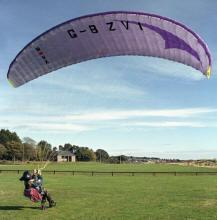|
|
|||||||||||||
 |
|||||||||||||
|
|
|
Are you a lazy efficient pilot at take off? |
|
|
|
For as long as I can remember I have been meeting pilots who take off as they were taught, by showing ‘lots of commitment’, running forward energetically whilst dragging their paragliders up in to the sky, normally this will lead to the aircraft diving after your feet leave the ground as the wing passes through the overhead so surging temporally further forward than normal in steady flight, due to gravity acting on the pilot swinging them back (relative to the forward moving wing), before finally settling back approximately above you but with the CoP (#) slightly in front of the pilots mass, remember in steady flight the pilot is acted on BOTH by gravity (directly downwards force) AND also acted on by drag (back along the pilots path through the air!). The combined resultant of gravity and pilot drag provides the wing loading, this vector is angled down & slightly back. |
|
# CoP = Center of Pressure, which is in simple terms the single point where the aerodynamic forces can be said to act, that is a imaginary single line attaching the pilot to a rigid PG shaped wing would act to move & support the pilot. |
|
Only once pilots work out for themselves that much of what is normally taught regarding PG theory is in fact badly in error will the sport, world wide, finally see a massive drop in take off accidents! Understanding that, in steady gliding flight the pilot is PULLED by the wing has the potential to slash PG ‘Launch Phase’ accident rates to near zero! Note: ‘Launch Phase’ accidents account for about 40% of PG accidents. |
|
A ‘normal’ PG take off, instructor calling “Run Run Run” |
|||
|
The lower airspeed that results from the pilot forcing the wing into a higher (positive) pitch will also force the wing into a higher AoA... all induced by the ‘thrust’ from the pilot (which of course disappears when your feet leave the hilltop).... the sudden loss of (pilot) Thrust as ground contact is lost will result in a (short term) change to an excessively negative pitch as relative to the wing the pilot swings backwards (wing surges & dives). The down pitch results in an increase in airspeed (pitch controls airspeed) and of course you get at best a slight dive which in light ridge lift can take you out of and below the limited lift band, however often the dive is more than just slight while you wait for the wing to start fully flying! |
|||
|
A bit of history |
|||
|
When looking at anything in aviation (see ‘fotogliders law’) history shows us one of the keys to improving is not just the ‘How’ but often the ‘Why’ things occur/are done etc. Looking back to the early days of the sport when many of those who write books/teach etc. learnt to fly, paragliders were, as looking at old pictures/videos shows, much closer to jump ‘chutes than current designs, with deep profiles, large frontal openings and low aspect ratios, because of this a committed run forward was generally the best launch method. Ask yourself, is it still the best method (‘committed run’) or should we move on and evolve training (and retraining) to reflect the improvements in the ‘hardware’ we now have available? |
|
Modern paraglider designs |
|
NOTE: On flat ground the PITCH of the wing ‘mid rising phase’ will be about 45*, as here we are looking a wind on a flat field the AoA of the wing would be presumed to be also about 45*.... BUT as AoA is a relative angle, the airspeed the glider has due to it’s movement (rather than the wind) results in a significant reduction in the (range of) Angles of Attack (across the curved span of the wing) below the ’presumed’ value of (mid-rise) 45* |
|
“Dynamic wind” (Newtons 3rd Law) to “Laminar Airflow” (Bernoulli’s Theorem) |
|||
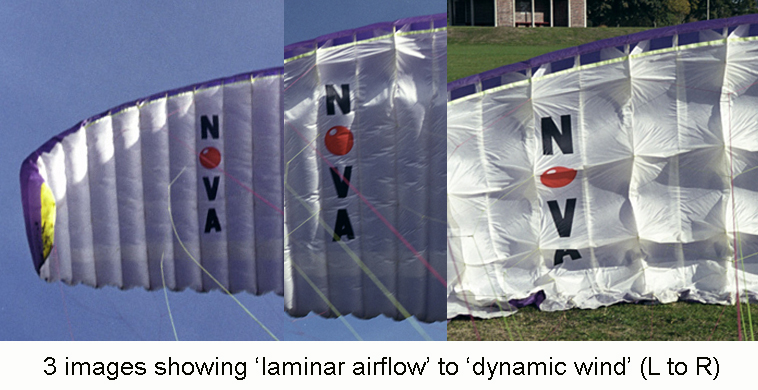 |
|||
|
Flying applies not just when you are off the ground but ANYTIME a laminar airflow passes across the top and bottom surface of the wing and generates ‘lift’ including during the early stages of a launch. |
|
This statement clearly need more explanation, here goes: |
|
Looking at the bottom surface of wing when it is in a wall we see that tension on the lines cause concave folds to the material, but when the wing is ‘flying’ (you can still be standing on the ground) we see that between the attachment points the wing is convex. The point at which the wing changes from being inflated (true ram air) due to wind blowing in the cells and on to the under surface, to being ‘sucked’ open (Bernoulli’s theorem) is when it changes from being just a parachute (a pure drag device) to a paraglider (an aircraft!) clearly if YOU make the change occur in advance of leaving the ground you are on a winner and will avoid any tendency to dive! |
|
Well the theory sounds ok but what has it got to do with being a lazy efficient pilot? |
|||||||||||||
|
Now we need to look at what the ‘old school’ and ‘new school’ take off’s are actually asking the wing to do? We will keep the numbers simple as this article is only to introduce an ‘idea of what is occurring’ to pilots who are interested in flying not having a math’s lessons! Runway 15 ft Line lengths 20 ft Pilot runs at a ‘fixed’ 10 mph Wing has a max speed of 20 mph (under 'normal' load/no speed bar applied) Imagine the perfect take off location with a nice easy light breeze you can choose to forward or XBRL (cross break reverse launch) it’s your choice and this article applies to both equally well. At our chosen spot we would like the wing stable and flying above us within 15 feet of the pilots starting point and nicely ready before the drop off at the ridge edge. So how far (and fast) will the wing have to move while the pilot moves 15ft? |
|||||||||||||
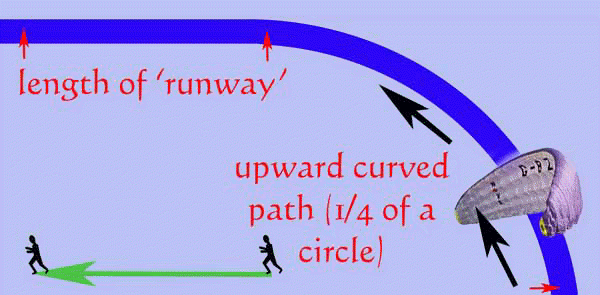 |
|||||||||||||
|
During the ‘Old school’ take off with the pilot giving a committed run does anyone want to bet that in 15ft the wing will still be hanging back? As while the pilot moves 15ft forward at 10 mph they are expecting the wing to move in an arc (1/4 of a circle) length 2 x 3.14…. (p) x 20 (radius) then divided by four (the distance is ¼ of a circle) plus the 15 feet the pilot moved. All this totals…… 15ft movement for the pilot and about 45ft for the wing… all within the same time if the wing is to be overhead by the end of the ‘runway’ and avoid the risk of a dive. Three times the distance in the same time gives an average speed required of 30 mph! Well above the max airspeed so no wonder the wing hangs back or the pilot needs a much longer take off run to give the wing time to catch up. |
|||||||||||||
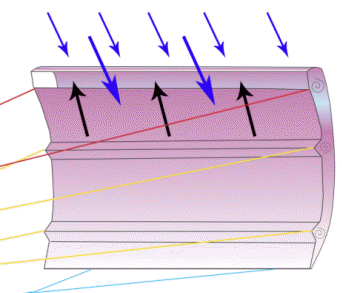 |
|||||||||||||
|
The blue arrows show the relative airflow (the combined effect of wind and upward movement of the glider) over the top and bottom surfaces of the wing as it moves up during a launch, the smaller the creases formed by the lines the quicker the airflow becomes laminar and attaches as the wing starts to fly up. In a ‘New school’ take off the pilot fly’s the wing up instead of running hard, ‘committed’ (an apt choice of terms perhaps!) being replaced by ‘curves’ used both in pressures and speeds as the pilot alters inputs to suit what the wing is doing at that moment. ‘New’ starts much as in the old method but as soon as air has been forced into the wing the pilot reduces riser pressure letting the airflow ‘attach’ to the upward accelerating wing instead of ‘wind’ pushing against it. Hint. It helps to get your flying buddies to video you and the underside of your wing to study this, less and smoother inputs being what you are looking to have, letting the wing get on with the job of flying as it is designed to do! The pilot may even alter their speed to such an extent that they change direction of movement to temporally move backwards under the rising wing (look at the pilot compared with the tree trunk in the background in picture 2 to see moving back under the wing) all the time monitoring the amount of force (and its direction) on the risers, which is ideally both up the length and to the front until overhead when most should be just up, as well as keeping in touch with the brakes (they indicate how much energy is in the wing) all this even in light conditions leaves runway in front of the pilot with the wing already stable and flying, letting the pilot AND the wing pick up ground (and more air) speed into a smooth lift off ready to work the ridge/thermals at max efficiency! |
|||||||||||||
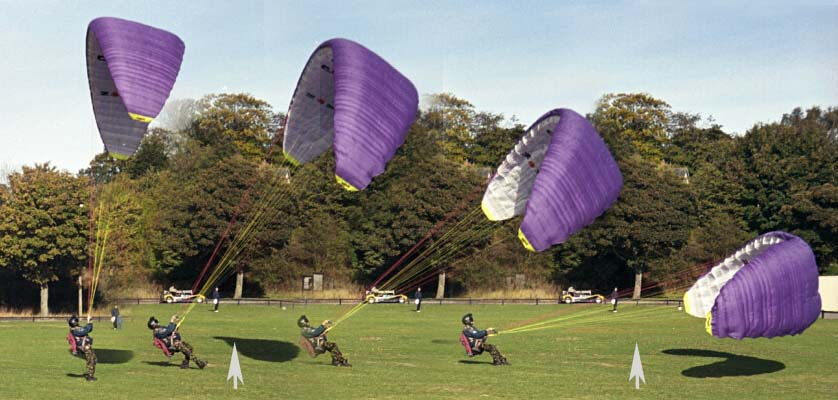 |
|||||||||||||
|
New school’ sequence showing the pilot moving back to under the rising wing. |
|||||||||||||
|
And the lazy bit? |
|||||||||||||
|
Well a lot less running about and plenty of chance to abort T/O before the end of the ‘runway’ if it feels that the lift is less than you thought it was, just drop the wing, bundle it out of the UV and chill out with your mates for another ½ hour while you wait for the day to start working instead of being the early wind dummy left with a hike back up! One of my favorite saying to new pupils is ‘wings are designed to fly, pilots are inclined to crash’ or as Gabe says on the ‘Paraglider show’ says “active piloting is often a case of choosing NOT to do something!” |
|||||||||||||
|
Footnote. While out shooting the photographs to help support this article a visitor to Scotland (Ex champion pilot in his home country) who is holidaying with friends in the UK came up to say hi, we lent him a Vertex 24 to fly and ended demonstrating many of the ‘new school’ control & safety procedures, he quickly decided that compared to the methods used in continental thermic locations the ‘New school’ gave more control and a lot less effort what ever the conditions! |
| [Home] [Dual Control] [Min Sink] [Control Options] [Lazy & Efficient] [Speed Systems] |


